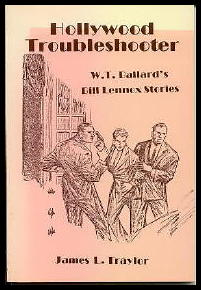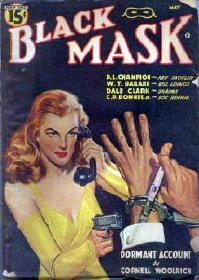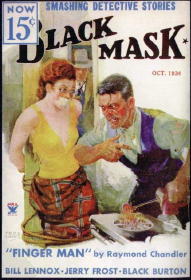Sun 24 Jun 2007
Review: W. T. BALLARD – Hollywood Troubleshooter.
Posted by Steve under Authors , Characters , Pulp Fiction , Reviews[6] Comments
W. T. BALLARD – Hollywood Troubleshooter. Edited by JAMES L. TRAYLOR. Popular Press, Bowling Green University; trade paperback; 1985. Also published in hardcover.

Subtitled “W. T. Ballard’s Bill Lennox Stories,” not only does this book contain five of the twenty-seven of them that appeared in Black Mask during that magazine’s heyday, probably the best-known detective pulp of them all, but all of the following are included as well: an overview of Ballard’s career by Traylor and a short biographical sketch by Ballard himself, both extremely informative; an introduction to the Lennox stories and novels; and last but not least, a complete bibliography for all of Ballard’s long and prolific writing career.
It’s a cliché, I suppose, but this is a book that should be on the shelf of every pulp detective fan, no ifs, ands or buts. After a lengthy career for the pulp magazines — even before he started writing for Black Mask in 1933, he had already been published in the October 1927 issue of Brief Stories — Ballard switched with the times to writing novels, some in hardcover, but most of them paperback originals.
When he found the market for his mystery fiction was drying up, Ballard switched to writing westerns, most of these coming out under the pen names of either Todhunter Ballard or John Hunter. In the 1950s and 60s he wrote a number of television plays as well, for such series as Death Valley Days, Wild Bill Hickok and Shotgun Slade.
While the Lennox stories in Black Mask appeared only from 1933 to 1942, he was apparently fond enough of Lennox as a character to continue writing about his adventures in hardcover form: Say Yes to Murder (Putnam, 1942), Murder Can’t Stop (McKay, 1946), and Dealing Out Death (McKay, 1947). Much later on, a fourth book, Lights, Camera, Murder (Belmont, pb, 1960), finally appeared, published for some reason under the name of John Shepherd.
Here’s a suggestion from me. Lennox may have been the first Hollywood troubleshooter to have appeared in fictional form, the right-hand man for Consolidated Studio’s production chief, Sol Spurck. Having no specific title, according to the last of the five stories in this book, Lennox’s assignment was “to iron out whatever bottlenecks developed in the production schedule.” Murder is often one of those bottlenecks, as well as any other kind of behavior that might affect the studio’s star and starlets — including blackmail, crooked horse racing, gambling debts or the like. (Hollywood, crime and cover-ups somehow seem to go together naturally, at least in days gone by, if not today.)
Whenever a pulp writer got a hot series going, there was often of crew of regulars that began to appear in the same stories the main character did, and Ballard was no different. (He may even have been one of the forerunners of the idea.) Given only self-contained glimpses here and there, and spread over the run, you won’t get the full flavor of this in the same way that a long-time regular reader of Black Mask might have been able to, but Nancy Hobbs, for example, who writes about movies, has short but very striking roles in the first two of them. Later on, it comes as no surprise to learn, she appears in his adventures as a long term girl friend and lover, although marriage does not seem to be in the cards for either of them.
The earlier stories are told in the more terse hard-boiled style popularized by Dashiell Hammett, but by the end of the run some personal background had been built up around Lennox, making him a bit more human — but without losing any of the sheer sensationalism of the pulps. Lennox’s final Black Mask appearance, for example, is a case in which a killer sends his victim through the buzzsaw at a still very much functioning lumber mill.
Although the tales contained in the book are, in all honesty, not among the finest the pages of vintage pulp magazine fiction can offer, they’re certainly right up there in the second level from the top. And if you’re like me, when you’ve finished reading the five in the book, you’re going to wish that somebody would publish them all of the Lennox stories, and then the “Red Drake” ones, then all of the Ace G-Man Stories, and on and on and on.
Stories contained in this volume, all from Black Mask:
“A Million-Dollar Tramp” October 1933
“Gamblers Don’t Win” April 1935
“Scars of Murder” November 1939
“Lights, Action — Killer!” May 1942 [his last magazine appearance]
Postscript: Looking back at this review several days later, all I can think of is that I didn’t provide you with an excerpt from any of the stories. This one’s from early in the very last one, “Lights, Action — Killer!” I don’t think it needs any more introduction from me, other than to say that Lennox is talking to Sol Spurck about the latter’s latest movie, which is in trouble, as usual:

At first he had dreamed of writing a book, a lot of books, but as the weeks drifted into years, he still spoke of quitting pictures, of going east and settling down to write.
That time never seemed to come. Through experience, he had learned to make his interest, his enthusiasms, and his softer feelings under a shell of hardness which was the only phoney thing about him. He had become flippant, since the town understood nothing else. He had ceased to admit that he could read, or that he liked good books. He gambled when he could, needing the false excitement of the game as a safety valve for his nerves.
But although he refused to admit it, even to himself, he was still moved by enthusiasm for each new picture, still hoped that some day someone would cut loose and make, not the old formula story, but something really new, something different. All the bitterness and boredom of his job was in his voice when he said, “They dipped the barrel dry for hokum on this, Sol. If we had Pearl White, we could make the greatest serial out of this that was ever made.”
“Funny,” said Spurck. “Mama and I was just talking at dinner. Them old days was different. Pictures was fun then, and not always the headache which we have now got.”
UPDATE [06-23-07]. Here, for the sake of completeness, is a complete list of Lennox short fiction:
“A Million Dollar Tramp” (October 1933, Black Mask)
“Positively the Best Liar” (November 1933, Black Mask)
“Trouble-Hunted” (January 1934, Black Mask)
“Tears Don’t Help” (April 1934, Black Mask)
“That’s Hollywood” (May 1934, Black Mask)
“Whatta Guy” (July 1934, Black Mask)
“Crime’s Web” (September 1934, Black Mask)
“Snatching is Dynamite” (October 1934, Black Mask)

“In Dead Man’s Alley” (November 1934, Black Mask)
“Murder Isn’t Legal” (December 1934, Black Mask)
“Gambler’s Don’t Win” (April 1935, Black Mask)
“Numbers With Lead” (January 1936, Black Mask)
“Blackmailers Die Hard” (May 1936, Black Mask)
“Whipsawed” (December 1936, Black Mask)
“There’s No Excuse for Murder” (September 1936, Black Mask)
“This is Murder” (March 1937, Black Mask)
“Fortune Deals Death” (July 1937, Black Mask)
“Mobster Guns” (November 1938, Black Mask)
“No Parole from Death” (February 1939, Black Mask)
“Scars of Murder” (November 1939, Black Mask)
“Pictures for Murder” (September 1940, Black Mask)
“The Lady with the Light Blue Hair” (January 1941, Black Mask)
“Not in the Script” (July 1941, Black Mask)
“Murder is a Sweet Idea” (November 1941, Black Mask)
“The Colt and the Killer” (February 1942, Black Mask)
“Lights, Action — Killer!” (May 1942, Black Mask)
Now don’t you wish that someone would publish them all?
June 24th, 2007 at 9:37 am
Steve,
I ran across Ballard, a friend of Norbert Davis, while doing research on Josef Hoffmann, then on Davis. Ballard’s book sounds very cool. Reading about Davis (and now about Ballard), I’ve become interested all over again in writers in Hollywood during the era when Davis and Ballard were working. Thanks.
Chuck
June 24th, 2007 at 10:06 am
Excellent review Steve. Looking over the list of stories reminded me once again that Black Mask and Dime Detective were full of interesting series characters that were well written and hold up well today when reread. There is someone who would be willing to publish them all. Battered Silicon. Of course George would need photocopies of the stories and the last time I photocopied a pulp I was actually weeping and moaning as I bent the fragile pages. I can’t put myself through such torture!
>> Walker
I feel your pain. Can you imagine sliding one of those early Black Masks into a scanner or copying machine, an issue like the one pictured with Raymond Chandler’s “Finger Man” in it, only to discover that the front cover has fallen off? And taken the first few pages with it? Aargh.
June 24th, 2007 at 3:53 pm
Fantastic review, Steve. You’ve got me determined to track this book down.
June 25th, 2007 at 5:41 am
Ballard was very good in his Westerns. And one of his later paperback mystery novels, MURDER LAS VEGAS STYLE, is also good. It features Mark Foran as the PI hero.
July 1st, 2007 at 12:04 am
[…] Of course, maybe you know all of this, and I’m berating the unberatable, not now, not almost 50 years later. (And by the way, my spell-checker doesn’t know that word either.) Both Bill Lennox and W. T. Ballard have come up for discussion here on Mystery*File not too long ago, mostly, as you’ll recall, in relation to his pulp magazine appearances in Black Mask between 1933 and 1942. […]
August 19th, 2023 at 7:05 am
[…] Ballard’s Lennox, trouble-shooter for a major Hollywood studio in the 1920s and 1930s, started work under Joe Shaw and worked into Ken White’s time. Possibly the first Hollywood detective. Reviewed in detail here. […]